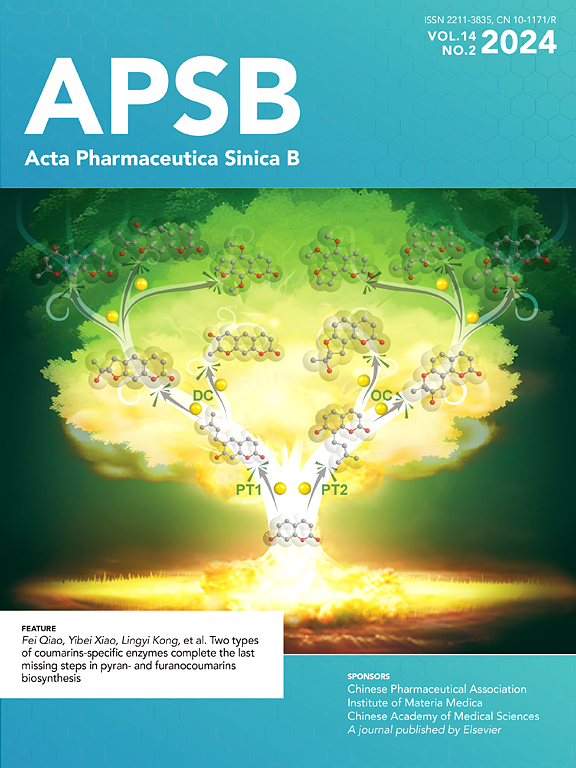海藻酸解酶固定化衣藻微机器人:生物膜穿透和清除的微创治疗
IF 14.6
1区 医学
Q1 PHARMACOLOGY & PHARMACY
引用次数: 0
摘要
细菌生物膜可以使传统抗生素难以穿透,甚至促进抗生素耐药菌株的发展。因此,迫切需要非抗生素策略来有效地穿透和根除形成的生物膜。在这里,我们展示了自推进型生物混合微型机器人的开发,该机器人可以在微创策略下增强对铜绿假单胞菌生物膜的降解和渗透效果。以莱茵衣藻(Chlamydomonas reinhardtii, CR)微藻为原料,利用海藻酸解酶(algate lysase, Alg)对其进行表面改性,通过生物正交反应构建了生物杂交微型机器人(CR@Alg)。通过降解生物膜组分,具有快速移动能力的CR@Alg微型机器人穿透生物膜的数量比微藻增加了约2.4倍。由于微藻固有的光敏剂叶绿素的存在,随后在激光照射下产生大量活性氧,从而触发光动力疗法(PDT)来对抗细菌。我们的基于藻类的微型机器人具有优异的生物相容性,能够有效地消除生物膜感染,并在体内抑制炎症反应,在生物膜相关感染的积极治疗中显示出巨大的前景。本文章由计算机程序翻译,如有差异,请以英文原文为准。

Alginate lyase immobilized Chlamydomonas algae microrobots: minimally invasive therapy for biofilm penetration and eradication
Bacterial biofilms can make traditional antibiotics impenetrable and even promote the development of antibiotic-resistant strains. Therefore, non-antibiotic strategies to effectively penetrate and eradicate the formed biofilms are urgently needed. Here, we demonstrate the development of self-propelled biohybrid microrobots that can enhance the degradation and penetration effects for Pseudomonas aeruginosa biofilms in minimally invasive strategy. The biohybrid microrobots (CR@Alg) are constructed by surface modification of Chlamydomonas reinhardtii (CR) microalgae with alginate lyase (Alg) via biological orthogonal reaction. By degrading the biofilm components, the number of CR@Alg microrobots with fast-moving capability penetrating the biofilm increases by around 2.4-fold compared to that of microalgae. Massive reactive oxygen species are subsequently generated under laser irradiation due to the presence of chlorophyll, inherent photosensitizers of microalgae, thus triggering photodynamic therapy (PDT) to combat bacteria. Our algae-based microrobots with superior biocompatibility eliminate biofilm-infections efficiently and tend to suppress the inflammatory response in vivo, showing huge promise for the active treatment of biofilm-associated infections.
求助全文
通过发布文献求助,成功后即可免费获取论文全文。
去求助
来源期刊

Acta Pharmaceutica Sinica. B
Pharmacology, Toxicology and Pharmaceutics-General Pharmacology, Toxicology and Pharmaceutics
CiteScore
22.40
自引率
5.50%
发文量
1051
审稿时长
19 weeks
期刊介绍:
The Journal of the Institute of Materia Medica, Chinese Academy of Medical Sciences, and the Chinese Pharmaceutical Association oversees the peer review process for Acta Pharmaceutica Sinica. B (APSB).
Published monthly in English, APSB is dedicated to disseminating significant original research articles, rapid communications, and high-quality reviews that highlight recent advances across various pharmaceutical sciences domains. These encompass pharmacology, pharmaceutics, medicinal chemistry, natural products, pharmacognosy, pharmaceutical analysis, and pharmacokinetics.
A part of the Acta Pharmaceutica Sinica series, established in 1953 and indexed in prominent databases like Chemical Abstracts, Index Medicus, SciFinder Scholar, Biological Abstracts, International Pharmaceutical Abstracts, Cambridge Scientific Abstracts, and Current Bibliography on Science and Technology, APSB is sponsored by the Institute of Materia Medica, Chinese Academy of Medical Sciences, and the Chinese Pharmaceutical Association. Its production and hosting are facilitated by Elsevier B.V. This collaborative effort ensures APSB's commitment to delivering valuable contributions to the pharmaceutical sciences community.
 求助内容:
求助内容: 应助结果提醒方式:
应助结果提醒方式:


